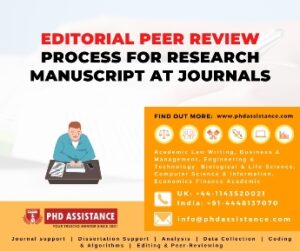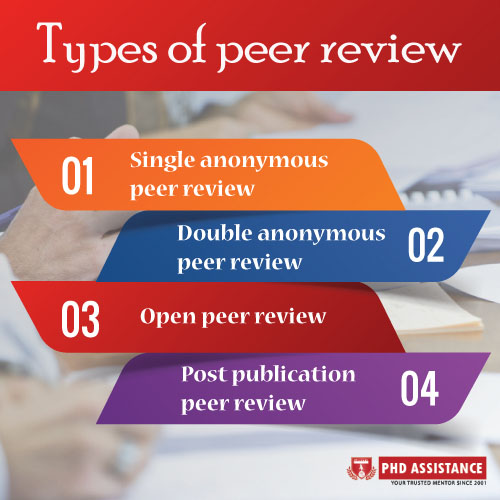Editorial Peer Review Process for Research Manuscript at Journals
In Brief
- The prospect of peer review is to evaluate the paper quality and suitability of publication
- Single anonymous peer review is most commonly used in medical science journals
- Peer review is essential for upholding the integrity and credibility of a scientific field

Introduction
Peer Review is the independent assessment of a Research Paper by experts in a specific field. The prospect of peer review is to evaluate the paper quality and suitability a publication of Peer Review Helps the author determine the originality, validity, and significance to help editors determine whether a paper is published in a certain journal. Peer review is very important for upholding the high impact factor journals and it can be used for maintaining the journal quality.

Figure: How Peer Review Works
Types of Peer Review
- Single anonymous peer review
- Double anonymous peer review
- Open peer review
- Post publication peer review
Single anonymous Peer Review
Single anonymous peer review is most commonly used in medical science journals. This kind of peer review is also termed as single blind review because the reviewers know only the author names and they don’t know who reviewed their Manuscript. The reviewers’ anonymity is designed to make it easier for them to provide complete and accurate information on an article without fear of retaliation from the author.
Double anonymous Peer Review
This kind of review is also termed as double blind review because the reviewer does not know the author name and the author does not know the reviewer of the manuscript. It specifically used in humanities and some social science journals. Most of reviewers are prefer double anonymous review because it avoids the risk of paper suffering from unintended bias of reviewers who know the nationality, gender and seniority of a paper’s author.
Open Peer Review
Open review contains reviewer name and article reports. Some open review journals will also publish previous versions of paper, allowing readers to see what changes were made as a result of peer review.
Post Publication Peer Review
Post-publication Reviewing Paper helps to get a broader variety of viewpoints, since peer review doesn’t stop when your paper is written; peers can add recommendations in the future that represent new developments.
Step by Step Guide to Reviewing a Manuscript
Overview of the review report format
The review report structures can varies from different journals.
Formal Methodology
Occasionally, they will ask you to address specific questions in your review via a questionnaire. Or they might want you to rate the manuscript on various attributes using a scorecard. Often you can’t see these until you log in to submit your review. So when you agree to the work, it’s worth checking for any journal-specific guidelines and requirements. If there are formal guidelines, let them direct the structure of your review.
Criterion to Concentrate on Peer Review
The core emphasis of a peer reviewer is the science. The determination of a peer reviewer is typically not to fix grammatical errors, spelling mistakes, or clunky language, but it does not offend to point them out to the authors. Every mistake or inhibition to successful communication caught early helps to improve the paper.
If the paper is systematically sound but is missing an experiment or wishes to have sections rewritten, it is appropriate to consent with major revision. Provide guidance to the authors and convey them what they need to do. Be patient and be organized to work with the authors on further drafts until it is ready for publication.
Benefits of Peer Review
The benefits of the peer review are numerous. Peer review is essential for upholding the integrity and credibility of a scientific field. It acts as an operative “filter,” spotting manuscripts of inadequate quality and ultimately avoiding flawed science from creating it to print. Peer review opens up important channels of communication among the authors, editors, and fellow reviewers, allowing all to be heard in a joint contribution to their field. Furthermore, it encourages authors to submit only original and impactful work, improving the quality and efficiency of the publication process.
Conclusion
There are so many characteristics of being a researcher that can go untaught (such as writing grants or lesson plans), and something as crucial to science as peer review should not be counted among these untaught subjects. By Reviewing Manuscripts Submitted to different journals, early-career researchers can become proficient in spotting content that is reliable and impactful and, just as importantly, content that does not meet the criteria for Submission to a Peer-Reviewed Journal.
References
- Burnham, John C. “The evolution of editorial peer review.” Jama 263, no. 10 (1990): 1323-1329.
- Lee, Carole J., Cassidy R. Sugimoto, Guo Zhang, and Blaise Cronin. “Bias in peer review.” Journal of the American Society for Information Science and Technology 64, no. 1 (2013): 2-17.
- Spier, Ray. “The history of the peer-review process.” TRENDS in Biotechnology 20, no. 8 (2002): 357-358.
- Tennant, Jonathan P. “The state of the art in peer review.” FEMS Microbiology letters 365, no. 19 (2018): fny204.
- Alberts, Bruce, Brooks Hanson, and Katrina L. Kelner. “Reviewing peer review.” (2008): 15-15.



